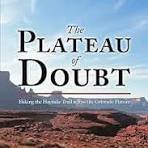Jonathon Stewart
Nonfiction 2018/ 329 pages
![]()
This is the only book I found by someone who hiked the Hayduke Trail, very different from the hundreds (thousands?) written by people who hiked the Appalachian Trail and the Pacific Crest Trail. I was excited to get my hands on it!
First, the trail itself. It isn't really a trail. It is an approximately 800-mile route through the Southwest, including six National Parks. Most of it is not on existing trails, but rather you find your way through guides, maps, tales others tell. Not many hikers are known to have hiked the Hayduke (but the numbers do include two of my favorite hikers, Carrot Quinn and Erin Saver - Wired). I can't find an accurate number of people who are believed to have hiked the Hayduke, but in 2019 some research was done by checking trail registers and permits, and the number then was believed to be about 40 hikers. So now, what, 200 hikers perhaps? A common phrase among Hayduke hikers is "figure it out." Probably no two hikers have followed the same route. There are challenges for getting up canyons, across washes, around waterfalls.
Named after George Washington Hayduke III, a fictional character in Edward Abbey's novel The Monkey Wrench Gang, the trail seeks to pay homage to Abbey for his tireless defense of these fragile and threatened public lands.
Though I loved this book, I must give it three hearts because I think many of my blog readers will not be enamored of it. You must be a diehard fan of the Southwest geography and history to really enjoy Stewart's story, and be fascinated by ancestral Puebloans, red rock spires, deep rocky canyons, lizards, constant searches for water, the desert in all its glory and threats, box canyons, bitterbrush, ruins, extreme heat and cold, pour offs, and descriptions of ancient stone formation.
In addition to navigating a route, and in tribute to Abbey, Stewart mixes in many topics, which some readers may find fascinating. The environment; the history of land preservation; water; uranium mining and contamination; climate and climate change; stock management of public and private lands; society's values; politics; endangered species; ATVs; guns; the role the Mormons played in "settling" the west; gates and locks and signs and barbed wire are all fair game in Plateau of Doubt.
The editing is atrocious. Misspellings, missed words, repeated words. I decided to include this comment in my post when, on page 175, three glaring errors (on one page!) offended my eyes. So, you must possess a high tolerance of errors such as these to enjoy this book..
All told, I can recommend this book to those who would be fascinated by hiking and a deep exploration of the geography of America's Southwest.
May 2024

